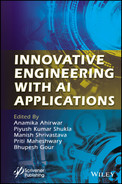12
Role of Artificial Intelligence in the Agricultural System
Nilesh Kunhare1, Rajeev Kumar Gupta2* and Yatendra Sahu3
1Vellore Institute of Technology (VIT) University, Bhopal, India
2Pandit Deendayal Petroleum University, Gujarat, India
3Indian Institute of Information Technology (IIIT), Bhopal, India
Abstract
In the economic sector, agriculture plays an important role. The biggest and emerging issue in the world is automation in agriculture. The population is increasingly rising, and the demand for food and jobs is also growing. These criteria were not fulfilled by the conventional methods used by farmers sufficient to satisfy them. New automated approaches have also been incorporated. These modern approaches have fulfilled food needs and have also provided billions of people with jobs. Artificial intelligence agriculture has brought about a revolution in agriculture. This technology has protected crop yield against many factors, such as climate change, population development, jobs, and food security issues. This chapter aims to explore various artificial intelligence applications, such as irrigation, weaving, sensor sprinkling, and other means in robots and drones, in agriculture. These technologies save excess water, pesticides, herbicides, preserve soil fertility, even lead to the efficient application of human resources and increase productivity and efficiency. This segment looks at several scientists’ work to quickly overview the latest automation of agriculture, robotic weeding, and drone systems. The different soil water sensing methods and two automated weeding techniques are discussed. This chapter will also address drones’ application and the various techniques used to spray drones and track crops.
Keywords: Crops, UAVs, machine learning, IoT, forecasting, machine learning, deep learning
12.1 Introduction
With the introduction of technology, many sectors worldwide have undergone a rapid transition. Surprisingly, though the least digitized, agriculture has seen traction in agricultural technology growth and commercialization. Artificial Intelligence (AI) is now playing an essential role in our everyday lives, broadening our perspectives and transforming the world [1]. Plessen [2] gave a method for preparing harvests based on the combination of crop distribution and vehicle routing. This new technology now helps many industries of employees who have been limited to just a minimal market. The AI department draws on the vast fields of Genetics, Psychology, Engineering and agricultural automation implementation. Jha et al. [3]. The article also explores a method for recognizing and irrigating flowers and leaves using IoT for botanical farming [4]. This technology is developed by studying how humans think, how humans learn and make decisions, and how they function while solving problems. On this ground, intelligent software and systems are developed. The basic concept of AI is to create a technology that works like the human brain. These softwares are supplied with training data and, like the human brain, these intelligent devices provide us with the optimal output for any valid input. AI’s main areas include machine learning (ML) [5] and deep learning (DL) [6]. ML will learn anything without being precisely programmed, and DL is learning from deep neural networks, while AI is the science of creating intelligent devices and programs [7]. The principal subjective of AI is to promote ANN problems.
Numerous environmental parameters that affect farming must be established at various locations to automate agricultural operations. Temperature, humidity, and water level are significant ecological parameters. Multiple types of sensors are mounted on the ground to track specific agricultural and micro-controller-related environmental parameters. In environmental conditions, the microcontroller controls various actuators or agricultural machinery (pumps, fans, etc.) without any human interference. Without human intervention, these sensed data can be saved in the cloud also. The wireless microcontroller sends sensed parameters to the cloud. GSM or CDMA/GPRS technologies are used for the majority of wireless environmental monitoring [8]. However, they have many drawbacks, including high network construction costs, low access rates, etc. The objects have a unique identity as part of the internet. Version 6 of the Internet Protocol (IPv6) [9], version 4 of the Internet Protocol (IPv4) is commonly used as the special entity recognition.
12.2 Artificial Intelligence Effect on Farming
Artificial information system encourages effectiveness and competitiveness in various fields. Solutions from AI help to solve the difficulties of tradition in all fields. Equally AI helps farmers in agriculture to enhance their effectiveness and to reduce negative impacts on the environment. In order to change the ultimate result, AI was firmly and openly adopted by the agriculture industry. AI moves the production of our food where emissions from the agriculture sector have decreased by 20%. The adaptation of AI technology helps monitor and handle any environmental circumstances that are uninvited.
The majority of start-ups now adapt AI-enabled approaches to boost agricultural production efficiencies in agriculture. The market survey report notes that global AI is projected to hit $1.550 million by the end of 2025 in agriculture [10]. Implementing IA-intensive approaches may quickly detect and respond intelligently to diseases or climate changes. Agriculture companies with the help of AI process farm data in order to minimize adverse effects. The world’s population will reach over nine billion by 2050, which will increase 70% to meet demand. If the world’s population increases, the supply chain of demand is not supplied by groundwater and services. Therefore, we need a better strategy, and how we farm and be most productive must be more successful.
In this chapter, the challenges that farmers face were based on using conventional agriculture methods and how artificial intelligence revolutionizes agriculture by replacing traditional methods with better methods and allowing the world to become a better place.
12.2.1 Agriculture Lifecycle
We may break the agricultural process into various parts as shown in Figure 12.1.
Soil preparation: This is the first step of agriculture in which farmers prepare the soil for seed. It includes breaking down large clusters of soil and extracting scraps like rocks, roots, and sticks. Add fertilizers and organic matter to create an optimal situation for crops, according to the crop type.
Seeding: The gap between two seeds, the depth for planting seeds, needs to be taken into account at this point. Climate conditions, including temperature, humidity, and precipitation play an essential role at this stage.
Adding fertilizers: Preserving fertility in soils is crucial in enabling farmers to continue cultivating nutritious and safe crops. Since these substances contain plant nutrients, including nitrogen, phosphorus, and potassium, farmers turn to fertilizers. To complement the necessary elements present naturally in the soils, fertilizers plant nutrients in agricultural fields. This process also decides the crop quality.
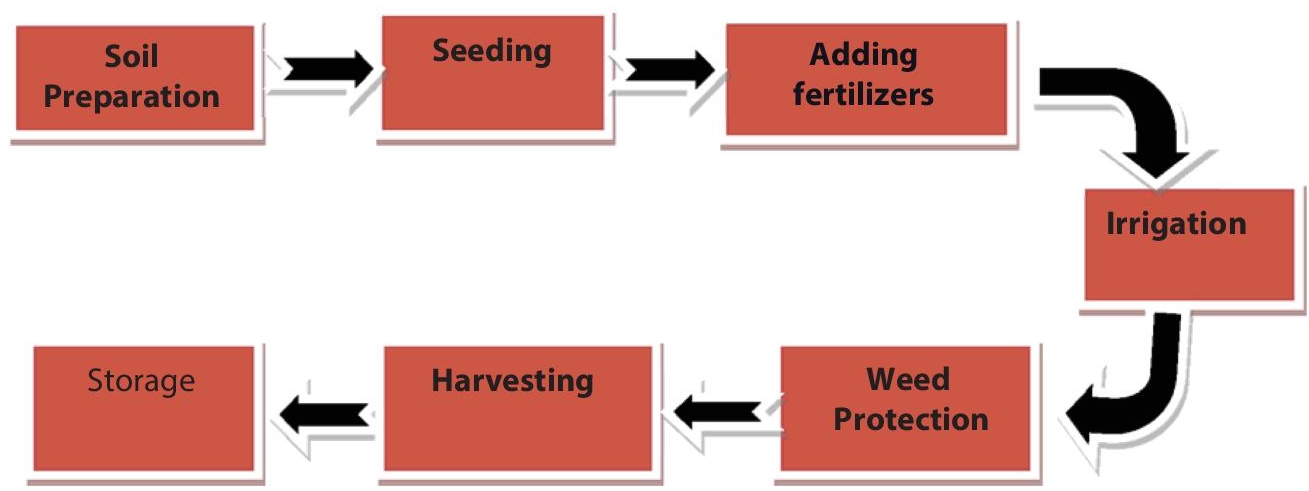
Figure 12.1 Lifecycle of agriculture.
Irrigation: The soil is kept moist and kept humid at this level. Under watering or watering can hinder crop growth, leading to damaged crops if not done correctly. Unintended plants that grow near crops or on farms are weeds protection.
Weed protection: Weed protection is essential as weed yield decreases, production costs increase, harvest interferes, and crop quality decreases.
Harvesting: It is the harvesting process from the fields of mature plants. For this operation, it needs a lot of employees, and it is labor-intensive. This process involves harvest treatment, such as washing, sorting, packing, and cooling.
Storage: The post-harvest process in which goods are stored to safeguard food protection other than during farming. The packaging and transport of crops are also included.
Storage: the post-harvest process in which goods are stored to safeguard food protection other than during farming times. The packaging and transport of crops is also included.
12.2.2 Problems with Traditional Methods of Farming
- In the lifecycle of agriculture, climate factors, including precipitation, temperature, and humidity, plays an essential role. Climate changes result in rising deforestation and emissions, so it is hard for farmers to decide on land preparation, sow seed, and harvesting.
- Each crop needs unique soil nutrition. The soil needs to contain three principal nutrients nitrogen (N), phosphorous (P), and potassium (K). Nutrient deficiency can result in low crop quality.
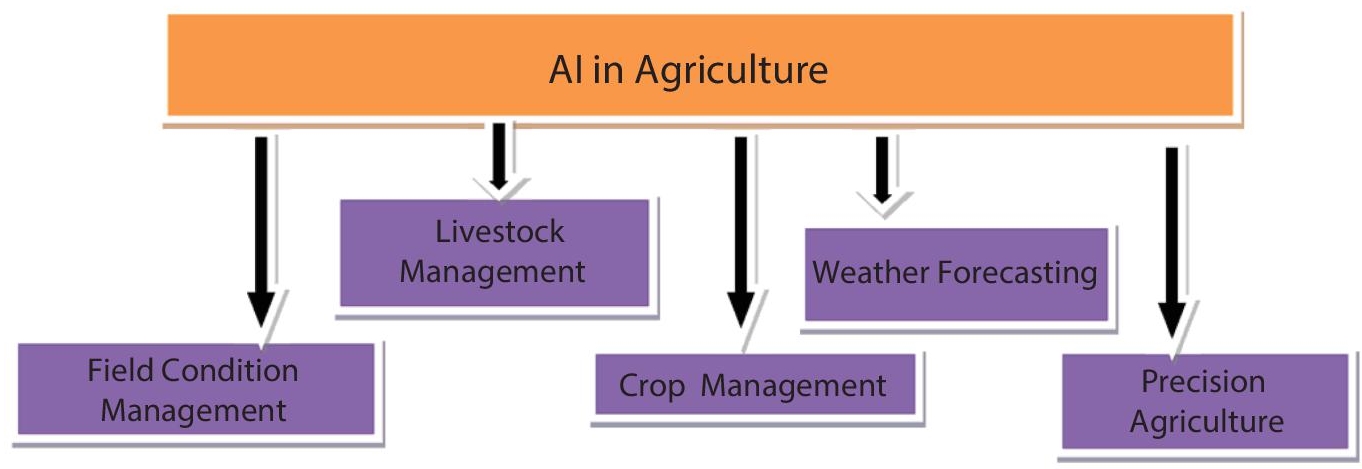
Figure 12.2 AI in agriculture system diagram [10].
- As can be seen from the farm life cycle, weeds’ defense has a critical role to play. Unless regulated, production costs can increase, and nutrients absorbed from the soil may cause the soil’s nutritional deficiency. Application of AI is shown in Figure 12.2.
12.3 Applications of Artificial Intelligence in Agriculture
12.3.1 Forecasting Weather Details
AI enables the farmer to maintain advanced weather knowledge up-to-date. Because of the predictable outcome, farmers’ returns and revenues without risking crops. The analysis of the data produced enables farmers to use AI to learn and understand precautions. A wise decision can be taken in time by using this practice. Figure 12.3 shows how the data is communicated between the IoT devices.
12.3.2 Crop and Soil Quality Surveillance
Using AI is an important way in which potential soil defects and nutrient shortages can be detected or monitored. AI detects potential flaws with the camera-captured images with the image recognition method. Using Al deep learning framework, flora trends in agriculture can be analyzed. Applications with this form of AI promote the understanding of soil defects, plant pests, and diseases. Figure 12.4 shows crop and soil quality surveillance process.
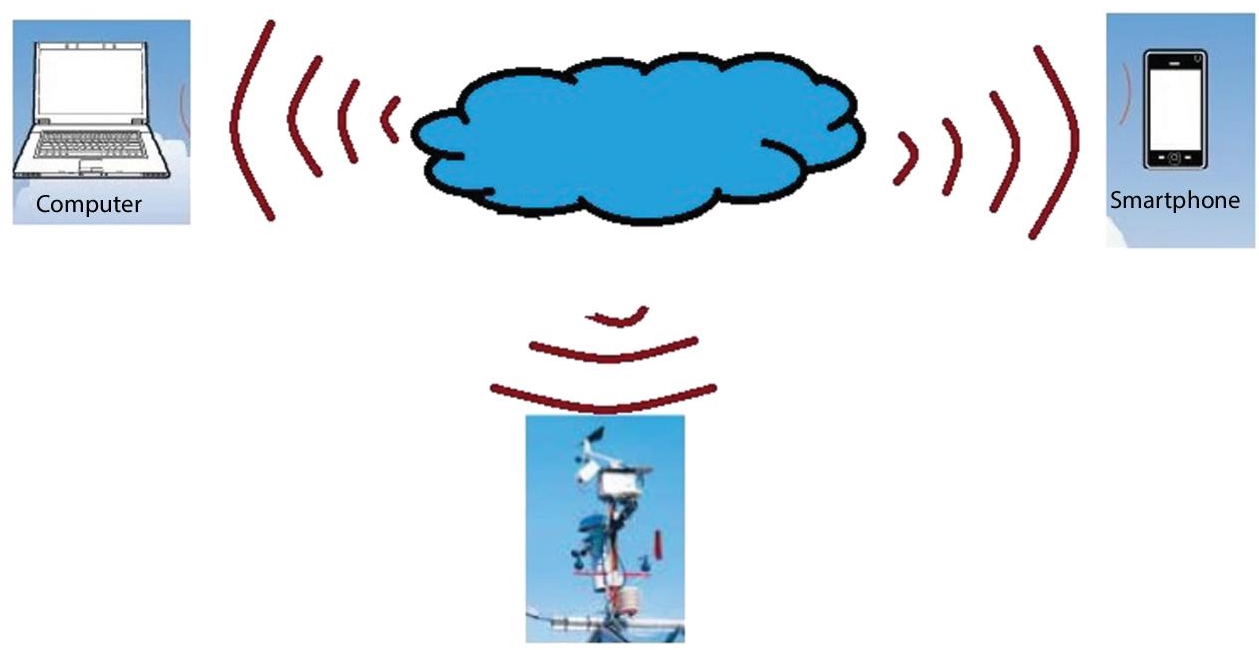
Figure 12.3 Forecasting weather details [11].

Figure 12.4 Crop and soil quality surveillance [11].
12.3.3 Pesticide Use Reduction
Farmers use AI to control weeds through computer vision, robotics, and machine learning. Data are collected with the AI’s aid to track the weed, which only sprays chemical substances when the weeds are found in farmers. This decreased the use of the chemical by spreading a whole field directly. As a result, AI reduces the number of chemical sprays commonly used by herbicides in the area.
12.3.4 AI Farming Bots
Farmers are helped by AI-enabling agriculture to find efficient ways of protecting their plants against weeds. It also helps to resolve the difficulty of work. AI bots can harvest crops at a higher volume and speed than human workers in the agricultural sector. Using computer vision, weed control, and spraying will helps farmers to find more successful ways to protect their plants from weeds.
12.3.5 AI-Based Monitoring Systems
- Monitoring of Microclimates
- Use environmental sensors for monitoring such aspects as temperature, relative humidity, sunlight, carbon dioxide, wind velocity, and generate crop growth mages.
- Send warnings via SMS/e-mail when the incident occurs to maintain optimum conditions.
- Display historical data and create trend graphs.
- Monitoring of Soil, Medium, Water
- PH, conductivity, temperature, humidity, soil/media track, etc. the best conditions for the development
- Track consistency of water, including pH, conductivity, temperature, oxygen dissolved, etc.
- Send warnings via SMS/e-mail when the incident occurs to maintain optimum conditions
- View historically stored data and create patterns in graphs
- Monitor Station for the Climate
- Use sensors for monitoring conditions of the atmosphere: temperature, moisture relative to the wind, direction of the wind, rain, snow, and sunlight.
- Maximize greenhouse production by studying the interplay and external temperature differential.
- Use historical analyses to forecast short-term temperature changes to increase indoor climate stability
- Power Monitoring and Analysis
- To see and monitor the electrical status of greenhouses, use sensors [11]
- To measure and evaluate the costs of individual devices, use documented power data
- Using shading networks automatically to minimize sunlight intensity and power consumption [12]
- Assess and change independent energy sources, according to the needs.
- Measure the overall cost of producing and using electricity
12.3.6 AI-Based Irrigation System
- Drip Method of Irrigation
To control the conductivity of soil moisture, pH levels, etc., use drip irrigation sensors.
- To monitor conditions and quality, use soil moisture sensors
- Permeability ensures pipeline water is used
- Drip devices attached to a PE pipe control the flow automatically.
- Weeds cannot grow without water between crops
- Drip irrigation systems: running, water, energy, and yield enhancement systems
- The crop roots retain ideal conditions to improve productivity when irrigated and fertilized directly to the ground.
Sprinkle Method
The method used for the Sprinkle Method is shown in Figure 12.5.
- Sprinkler device monitor soil moisture sensors
- Signals from analog to analog sensors are converted
- Transform signals to a linear value of the soil humidity meter
- Track conductivity of soil moisture, pH, and other sprinkler data for best usage.
- Include monitoring strategies, timetable, and quantity
- Automatic salinity correction while freezing.
- Small construction costs and quick foliar absorption increase greenhouse moisture and decrease the temperature
- Control framework for low cost and manufacturing irrigation
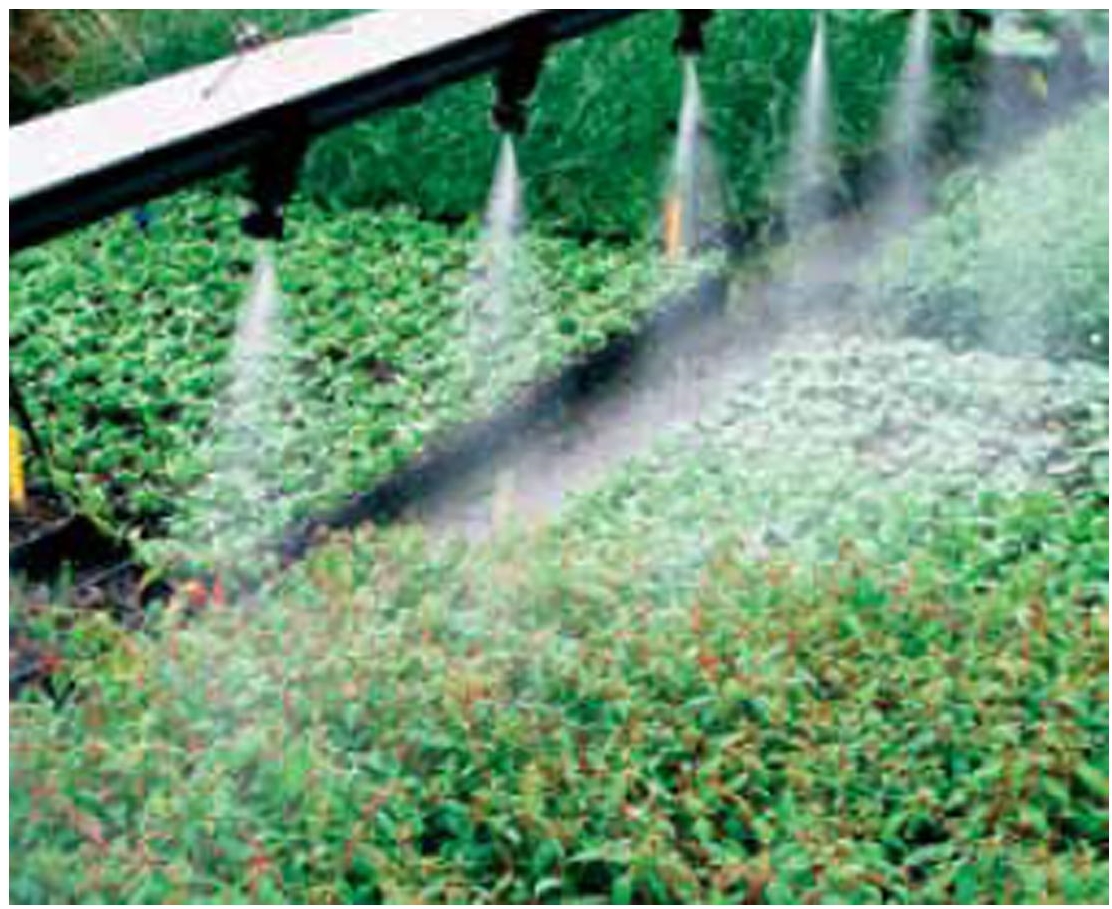
Figure 12.5 Sprinkle method [11].
12.4 Robots in Agriculture
Robot production by AI companies can easily accomplish several tasks in agriculture. This robot is trained to manage weeds and crops faster than humans with higher volumes. These types of robots are equipped to check crop quality and simultaneously detect weeds while planting and packaging. The robots are also capable of confronting the difficulties of farm work.
Agricultural robots automate sluggish, repetitive, and uncomfortable activities for farmers so that they can concentrate more on raising overall yields. For some of agriculture’s most famous robots:
- Harvesting and picking [13]
- Regulation of weeds [14]
- Autonomous mowing, pruning, seeding, spraying, and thinning [4]
- Phenotyping
- Sorting and packing
- Utility platforms
The precise use and speed of robots in agriculture are among the most common robot applications because of their ability to increase yields and minimize crop waste. However, it can be hard to automate these programs. For instance, there are several obstacles to a robotic system designed to collect sweet peppers. The location and maturity of pepper must be assessed by visual systems under harsh conditions, including dust, changing light intensity, temperature changes, and wind movement. But more than advanced vision systems are still required to choose a pepper. A robotic arm has as many challenges to traverse environments to grab and position a pepper gently. This method varies significantly from the selecting and placing of a metal component on a link line. In a complex environment, the agricultural robotic arm must be versatile and precise enough not to damage the harvested pepper [15].
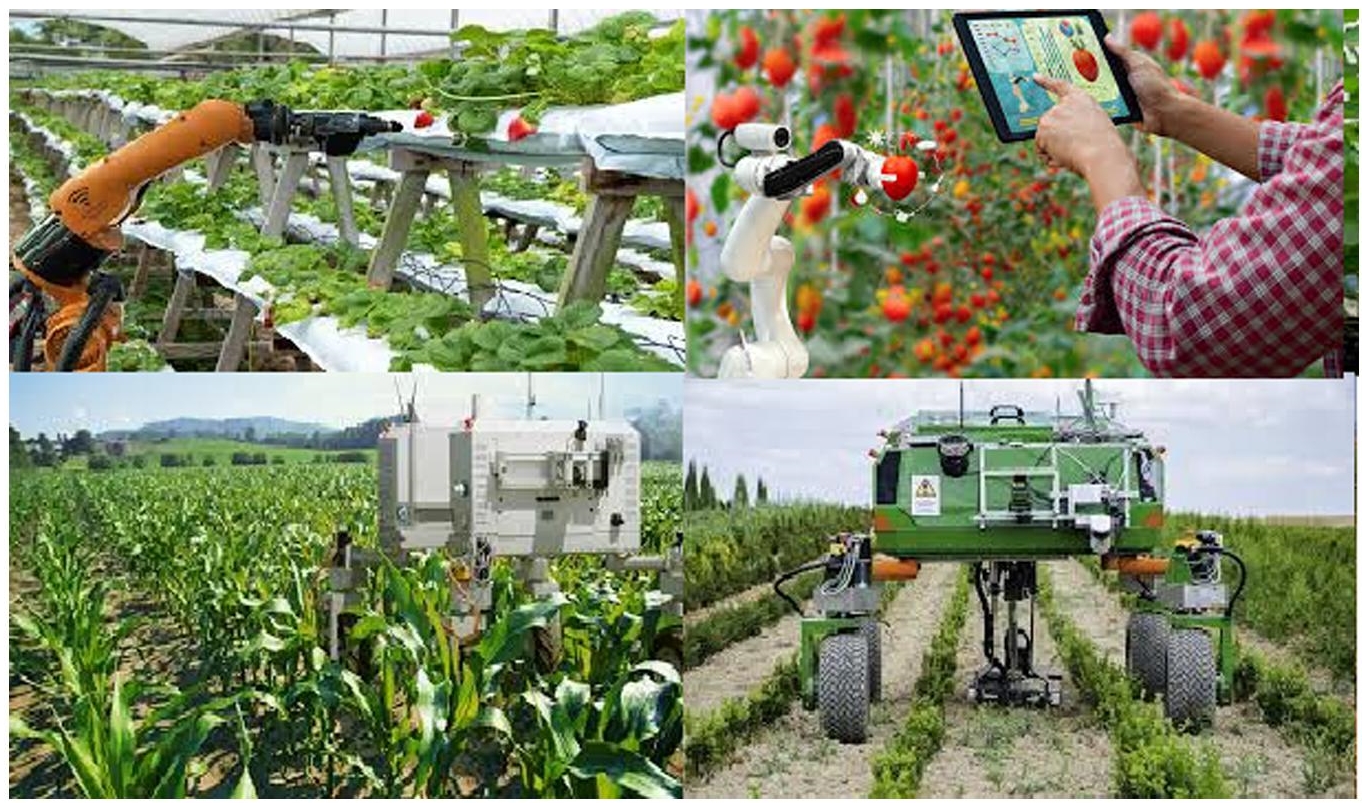
Figure 12.6 Robot in agriculture [17].
Farmers have become increasingly familiar with harvesting or picking robots, but hundreds of other creative ways in which the agricultural sector uses robotic automation to increase their production. Food demand is beyond the available agricultural lands, and farmers must resolve this void. Farming robots are just helping them [16]. Figure 12.6 shows how robot is used in agriculture.
12.5 Drones for Agriculture
SkySqurrel technologies brought drone-based Ariel imaging solutions for crop health monitoring. The drone gathers data from fields and transfers data from the drone to a device through a USB drive and is analyzed by experts [17]. Using the drones, which are also known as UAVs, farmers may collect data from the comfort of a single take-off zone over the entire field. With more models offering longer flight times, higher payload capacities, and the possibility to flight under variable conditions. Drones are more available to farmers, farm insurers, and researchers. Drones are used for agricultural operations of all sizes to reduce the time and costs involved in collecting crop data [18]. Figure 12.7 illustrates how drone is used in agriculture.

Figure 12.7 Drone for agriculture [17].
12.6 Advantage of AI Implementation in Farming
The use of artificial intelligence products in agriculture helps farmers understand temperature, precipitation, wind speed, and solar radiation. The study of historical values provides a more transparent comparison of the desired effects. The best aspect of AI introduced in agriculture is that human farmers’ jobs are not abolished, but their processes are enhanced.
- AI offers better ways in which essential crops are processed, harvested, and sold.
- Implementation of the AI emphasizes the monitoring of defective crops and enhancement of crop production potentials.
- The development of technology for artificial intelligence has improved the productivity of agribusinesses.
- AI is used in automated weather forecasting machine adaptations or the detection of diseases or pests.
- Artificial intelligence can also boost crop management practices, making more technology companies invest in agriculture algorithms.
- AI solutions can address farmers’ problems, such as climatic changes, pests, and weeds infestations that reduce yields.
- Agricultural influence of artificial intelligence.
AI technology quickly corrects the problems and advises concrete steps to fix the issue. To find solutions rapidly, AI is efficient in tracking the details. See how AI is used to boost performance with minimal environmental costs in agriculture. AI can identify a disease with 98% precision. Therefore, AI allows farmers to track fruit and vegetables by adapting the luminaire to speed up production.
12.6.1 Intelligent Agriculture Cloud Platform
12.6.1.1 Remote Control and Administration in Real Time
Real-time testing and next line control via computers, tablets, cell phones, and other devices remotely. Manage systems spread across multiples greenhouses, nutrients, temperatures, etc. Provide various degrees of authority for employees. Obtain information in real-time via SMS and email notifications History data and charts analysis—integrated research charts for improved crop cultivation. For potential review and queries, sensor data are automatically uploaded to the cloud. Provides public and private cloud.
12.6.1.2 Consultation of Remote Experts
Share the experience of greenhouses and other greenhouses with guidance. Enhance the training of farmers by supplying them with the most recent green technologies. Information about the production system documents, for example. Place, farmers, quality of soil, growth, harvest time, use of fertilizer, etc. We have automated record output for an accurate quality record regulation, residues of pesticides, etc.
12.7 Research, Challenges, and Scope for the Future
Artificial intelligence in agriculture has developed applications and devices that support inaccurate and regulated farming by providing farmers with proper guidance in water management, crop rotation, and early harvesting. With the application of machine-learning algorithms connected with satellite and Drone imagery, AI-enabled technology predicts weather, analyses crop sustainability, and evaluates farms with low temperature, precipitation, wind speed, and solar radiation for the presence of diseases, pests, and insufficient plant nutrition in farms.
AI profit can be obtained from farmers without connectivity with simple tools like an SMS and the sewing app. Meanwhile, Wi-Fi farmers may use AI applications to receive a continually tailored AI plan for their countries. Farmers will meet the world’s needs for increasing food production and income without reducing valuable natural resources through IoT and AI-driven solutions. AI will enable farmers to grow into farm technologists in the future, using data to maximize yields in individual plant rows. Pareek et al. [19] have proposed an artificial neural network (NNN) model to predict the cell fill of a sloped plate seed measuring unit. The PSO algorithm has been used to obtain optimum operating parameter values that are equal to 100% cell fill. Tewari et al. [20] have built a system consisting of image acquisition web cameras, image processing portable computers, system operations microcontrollers, and spray nozzles with the solenoid valve’s help. The chromatic aberrating (CA) image segmentation method was used to detect the diseased zone of paddy plants. The device further determined the severity level from paddy plants’ disease, which was based on a fixed time-length of the solenoid valves to spray the required agrochemical quantities on the diseased paddy plants. New automated methods have been implemented by Talaviya et al. [4] These modern approaches met food demands and also gave billions of people a chance to work. This technology has protected crop yields against different factors such as changing climate conditions, population growth, jobs, and food security issues. This paper focuses on the audit of various applications in agriculture of artificial intelligence: irrigation, weeding, spraying with sensors and other devices integrated with robots and drones.
Anami et al. [21] developed the deep-convolutional neural network (DCNN) System to automatically identify and distinguish various biotic and abiotic crop stresses. The work has adopted the VGG-16 CNN model pre-trained to automatically identify stressed paddy cropping images collected during the boot growth process. The qualified models achieve an average data set accuracy of 92.89%, showing the technological feasibilities for depth learning with 30.000 pictures of five different paddy crops with 12 different stress categories (including normal/healthy).
12.8 Conclusion
Artificial agricultural intelligence not only aids farmers to automate their agriculture and transforms them into accurate crop production for greater crop yield and better quality by using fewer resources. Companies that contribute to the development of machine learning or goods or services based on artificial intelligence, such as farm data training, drones, and automated machine processing, can provide the industry with a better technological advance, enabling the whole world to tackle food-producing problems for the increasing population.
References
- 1. Vinuesa, R. et al., The role of artificial intelligence in achieving the sustainable development goals. Nat. Commun., 11, 1–10, 2020.
- 2. Plessen, M.G., Coupling of crop assignment and vehicle routing for harvest planning in agriculture. arXiv, 2, 99–109, 2017.
- 3. Jha, K., Doshi, A., Patel, P., Shah, M., A comprehensive review on automation in agriculture using artificial intelligence. Artif. Intell. Agric., 2, 1–11, 2019.
- 4. Talaviya, T., Shah, D., Patel, N., Yagnik, H., Shah, M., Implementation of artificial intelligence in agriculture for optimisation of irrigation and application of pesticides and herbicides. Artif. Intell. Agric., 4, 58–73, 2020.
- 5. Liakos, K.G., Busato, P., Moshou, D., Pearson, S., Bochtis, D., Machine learning in agriculture: A review. Sensors (Switzerland), 18, 1–15, 2018.
- 6. Kamilaris, A. and Prenafeta-Boldú, F.X., Deep learning in agriculture: A survey. Comput. Electron. Agric., 147, 70–90, 2018.
- 7. Kodali, R.K. and Sahu, A., An IoT based soil moisture monitoring on Losant platform, in: Proceedings of the 2016 2nd International Conference on Contemporary Computing and Informatics, IC3I 2016, 2016.
- 8. Gupta, R. and Jain, K., Competition effect of a new mobile technology on an incumbent technology: An Indian case study. Telecomm. Policy, l. 40, 332– 342 2016.
- 9. Melorose, J., Perroy, R., Careas, S., Compression format for IPv6 datagrams over IEEE 802.15.4-based networks. Statew. Agric. L. Use Baseline 2015, 2015.
- 10. Misra, N.N., Dixit, Y., Al-Mallahi, A., Bhullar, M.S., Upadhyay, R., Martynenko, A., IoT, big data and artificial intelligence in agriculture and food industry. IEEE Internet Things J., 1–19, 2020.
- 11. https://www.proxis.ua/files/documents/Advantech%20Intelligent%20Agricultural%20Solutions%2008181118.pdf
- 12. Murugesh, R., Hanumanthaiah, A., Ramanadhan, U., Vasudevan, N., Designing a wireless solar power monitor for wireless sensor network applications, in: Proceedings of the 8th International Advance Computing Conference, IACC 2018, 2018.
- 13. Zhao, Y., Gong, L., Huang, Y., Liu, C., A review of key techniques of vision-based control for harvesting robot. Comput. Electron. Agric., 127, 311–323 2016.
- 14. Newswire, P.R., Agricultural Robots and Drones 2017-2027: Technologies, Markets, Players, PR Newswire, Dublin, US, 2017.
- 15. Tran, T.H. et al., The study on extraction process and analysis of components in essential oils of black pepper (Piper nigrum L.) seeds harvested in Gia Lai Province, Vietnam. Processes, 7, 1–18, 2019.
- 16. Xiong, Y., Ge, Y., Grimstad, L., From, P.J., An autonomous strawberry-harvesting robot: Design, development, integration, and field evaluation. J. Field Robot., 37, 202–219, 2020.
- 17. https://www.proxis.ua/files/documents/Advantech%20Intelligent%20Agricultural%20Solutions%2008181118.pdf
- 18. Hufkens, K. et al., Monitoring crop phenology using a smartphone based near-surface remote sensing approach. Agric. For. Meteorol., 265, 327–337, 2019.
- 19. Pareek, C.M., Tewari, V.K., Machavaram, R., Nare, B., Optimizing the seed-cell filling performance of an inclined plate seed metering device using integrated ANN-PSO algorithm. Artif. Intell. Agric., 5, 1–12, 2020.
- 20. Tewari, V.K., Pareek, C.M., Lal, G., Dhruw, L.K., Singh, N., Image processing based real-time variable-rate chemical spraying system for disease control in paddy crop. Artif. Intell. Agric., 4, 21–30, 2020.
- 21. Anami, B.S., Malvade, N.N., Palaiah, S., Deep learning approach for recognition and classification of yield affecting paddy crop stresses using field images. Artif. Intell. Agric., 1–13, 2020.
Note
- *Corresponding author: [email protected]
